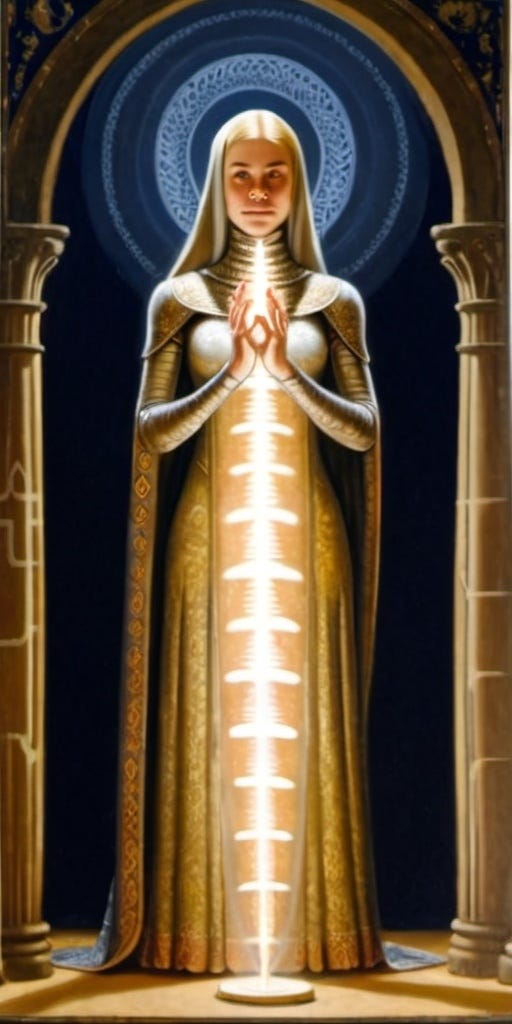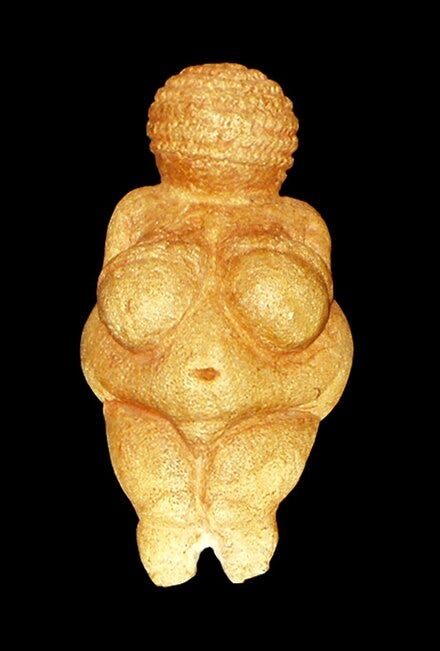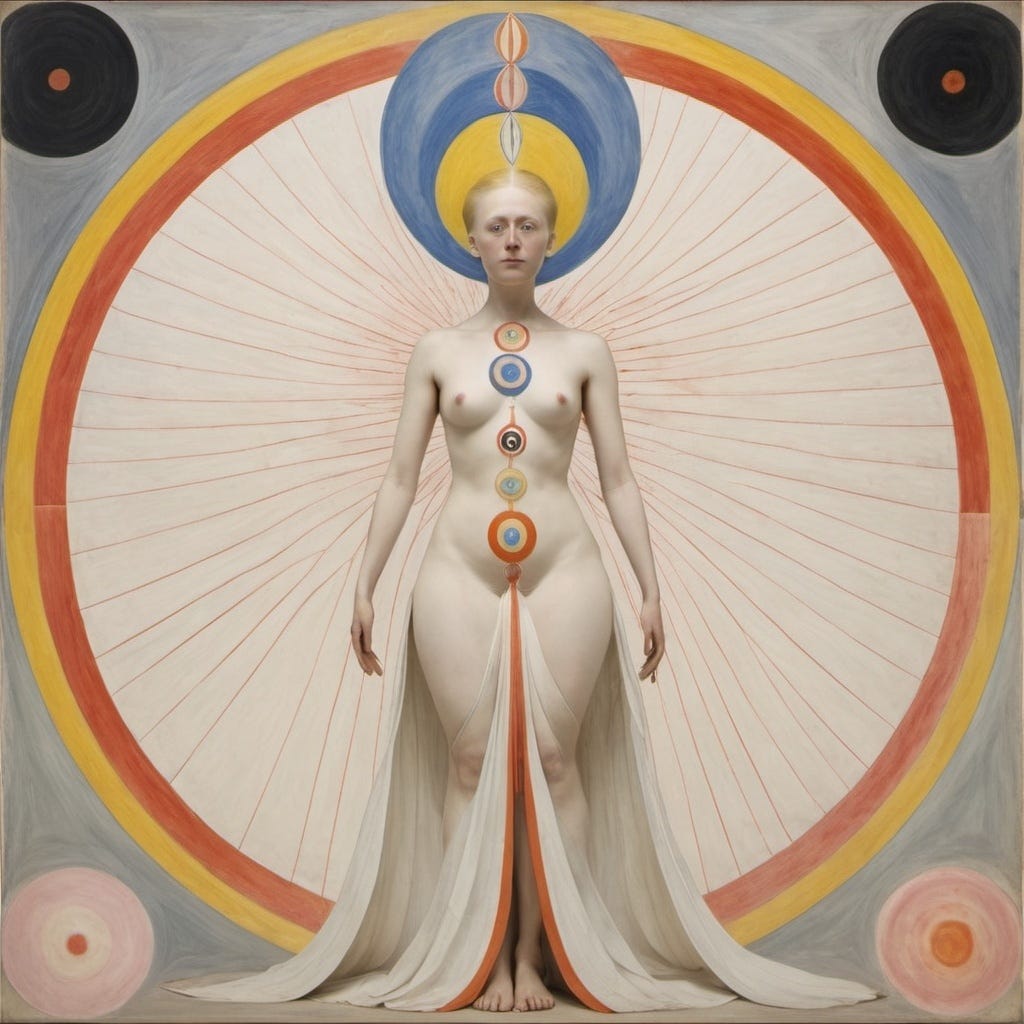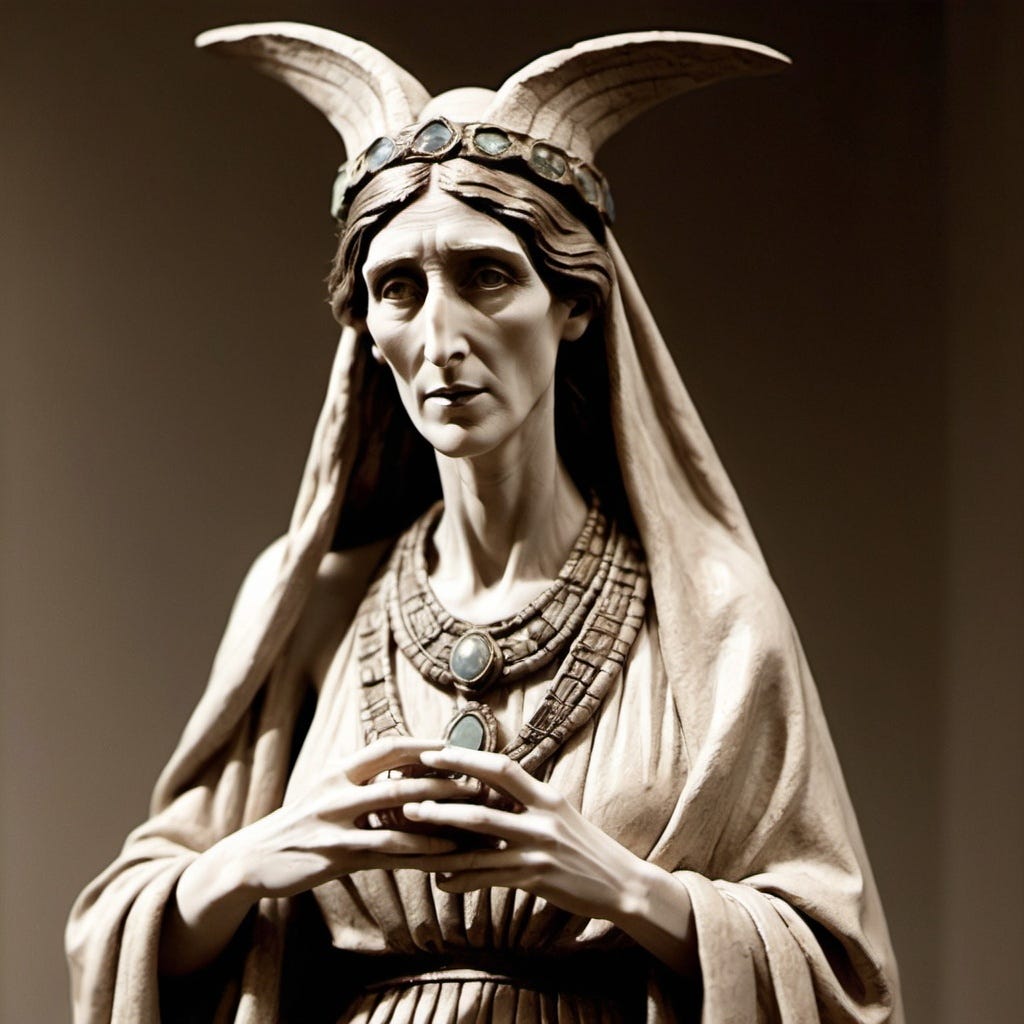A new (weird) iconography of the more-than-fertility goddess
An experiment inspired by Paleolithic art, Virginia Woolf, Evelyn Underhill, and Hilma af Klint. Who will yell at me for using AI?!
There’s only a tiny handful of tickets left for The Idyllegy—An Unravelling. This free event won’t be repeated and it won’t be like anything you’ve experienced before. Wednesday night. Bridewell Hall, off Fleet Street. An experiment in language, ritual, and attention.
Have you met this woman?
As a person who is weirdly obsessed with prehistory, I’ve spent quite a lot of time looking at her and her sisters. Figurines just like her—commonly known as Venus figurines—have been found all over Europe. They’re the oldest known examples of figurative art, dating to the Paleolithic. The oldest is 35,000 years old.
We don’t really know anything about these figures. Not why they were made. Not how they were used. Not who made them. All we have for sure is the objects themselves, and their geographical spread.
And so of course academics have speculated about them endlessly, because there ain’t nothin as provocative as a naked female body.
Here’s a game! You’ve got three tries to guess the most common interpretation of these figurines. Ready?
3.
2.
1.
What did you guess? Was “fertility goddess” up there? If so, you’d be in line with most commentaries I’ve read. The classic reasoning goes that because these figures tend to have rounded bellies as well as exaggerated breasts and sometimes vulvas, they must symbolize pregnancy and therefore fertility.
The thing is… that doesn’t look at all like a pregnant woman to me. Does it to you? The shape and position of the belly, and the texture the stone seems to convey, seem all wrong for the drum of a pregnant belly.
I’m not alone in thinking this. Here’s one interesting voice of dissent in the Washington Post a few years ago:
‘The figurines are certainly based on real life body morphology. They are anatomically accurate, and bear no resemblance to pregnant women,’ said David Haslam, a British physician and chair of the National Obesity Forum, a professional organization. He has written about the artifacts. ‘Similar figurines exist in Malta, Israel and all over Europe, proving that obesity existed in antiquity.’
And more famously, here’s the archaeologist Marija Gimbutas, who argued that all of what is now Europe used to worship a great goddess (until Indo-Europeans and their culture invaded and brought with them the male sky gods):
Fertility is only one among the Goddess’s many functions. It is inaccurate to call Paleolithic and Neolithic images “fertility goddesses,” as is still done in the archaeological literature. Earth fertility became a prominent concern only in the food-producing era; hence it is not a primary function of the Goddess and has nothing to do with sexuality. The goddesses were mainly life creators, not Venuses or beauties, and most definitely not wives of male gods.
You tell ’em, Marija.
Truth is, I hate reading that these figurines must be fertility goddesses. I hate it because it bums me the hell out that this is our culture’s automatic read. This kneejerk labeling doesn’t tell us much at all about the Paleolithic, but it tells us an awful lot about ourselves. About our cultural blind spots. The smallnesses we labour under. All the many sides of life and spirit that are invisible to us, whether we know it or not and whether we live in female bodies or not and whether those bodies have made children or not.
I happen to know that even if it doesn’t grow a human life, a body can have transcendent capacities. Can be a portal to the otherworld. Can light up with meaning and connection to the source of all life.
I happen to know this because the body I’m in happens not to have had children, and because—in my case as a direct result of not having children—I have found all manner of incredibly cool other capacities in it. Like the way my imagination lives not in my head but in my spine—in a bright, warm, sometimes piercing light that runs up my spine. Like the fact that in the still-dark small hours of winter mornings, my body doesn’t exist at all. I can melt clean out of it and into the imaginal realm.
I also know how many ways there are for a body to be magic because, by complete but happy coincidence, it turns out that my personal goddesses—the heroines who inspire me and guide my life—also lived in bodies that did not make children and were entirely magical anyway.
So, because you can’t be what you can’t see, I decided to start making a personal iconography.
And because I am one person still practising my painting and yes, I kind of do want to be a sorcerer in the age of mythic powers, I used AI.
And because I suspect that some of you also need to be reminded today that transcendent humanhood can take many forms—
I’m sharing this weirdo experiment with you. It’s silly. But for me at least, it hits. Let me know if these hit for you. I plan to make more.

Well, this has been an exceptionally strange post, and I’m glad, because I’ve resolved to drop any last pretence of being normal. What a relief.
Love,
xx Ellie





Such a good point about the Venuses not looking pregnant! It's always puzzled me how Neolithic people could also be that size given their diets...and maybe that's the point? A kind of beauty ideal of abundance and plenty? I wonder if this was at all relates to their idea of fullness, satiation, and absence of hunger.
OK, so I have had this idea and maybe someone has already done it, but I'm always wondering, why the hell aren't archeologists doing shamanic journeying to gather more information about prehistoric sites? And, because you wouldn't want to taint the unconscious of new archeologists (or really, whoever wanted to dive in to this practice) your shamanic experience would of course be an initiation after which you could read the accounts of all the journeys others had taken. They would have to be secret, for a specified or unspecified amount of time, because of the aforementioned possible tainting of the unconscious. But it's quite possible there could be overlap and really interesting information uncovered. I am saying this to you now because I too spend an inordinate amount of time thinking about prehistoric life and awareness. I even had a ceramic artist make me a copy of the Dreaming Goddess of Malta which is of course on my dream altar. Of course I'm realizing now that maybe this has already been done, but because it has to be secret nobody knows about it. Maybe I should go on my own journey and see what comes up. Will report back. Will not use AI, sorry.